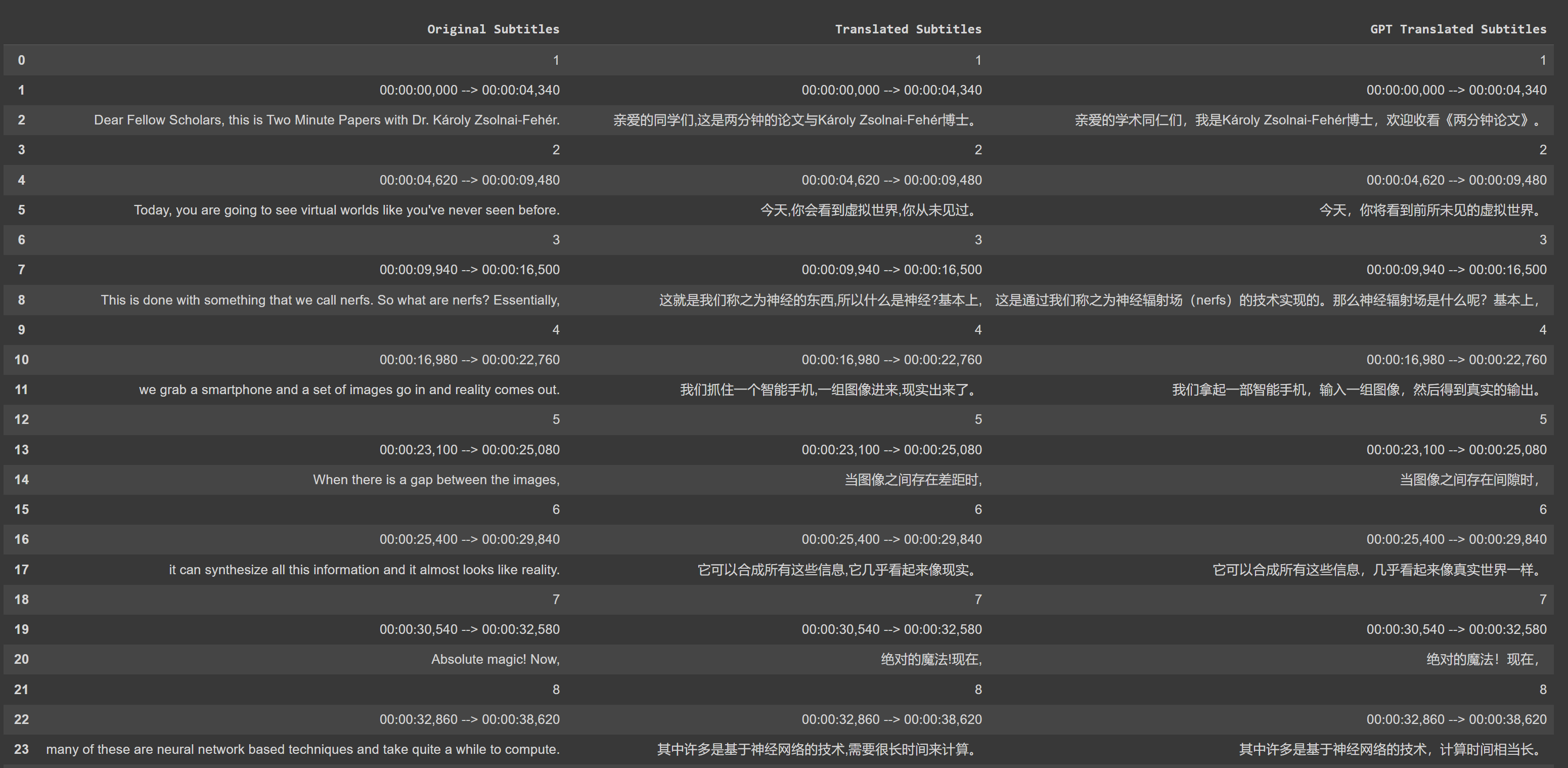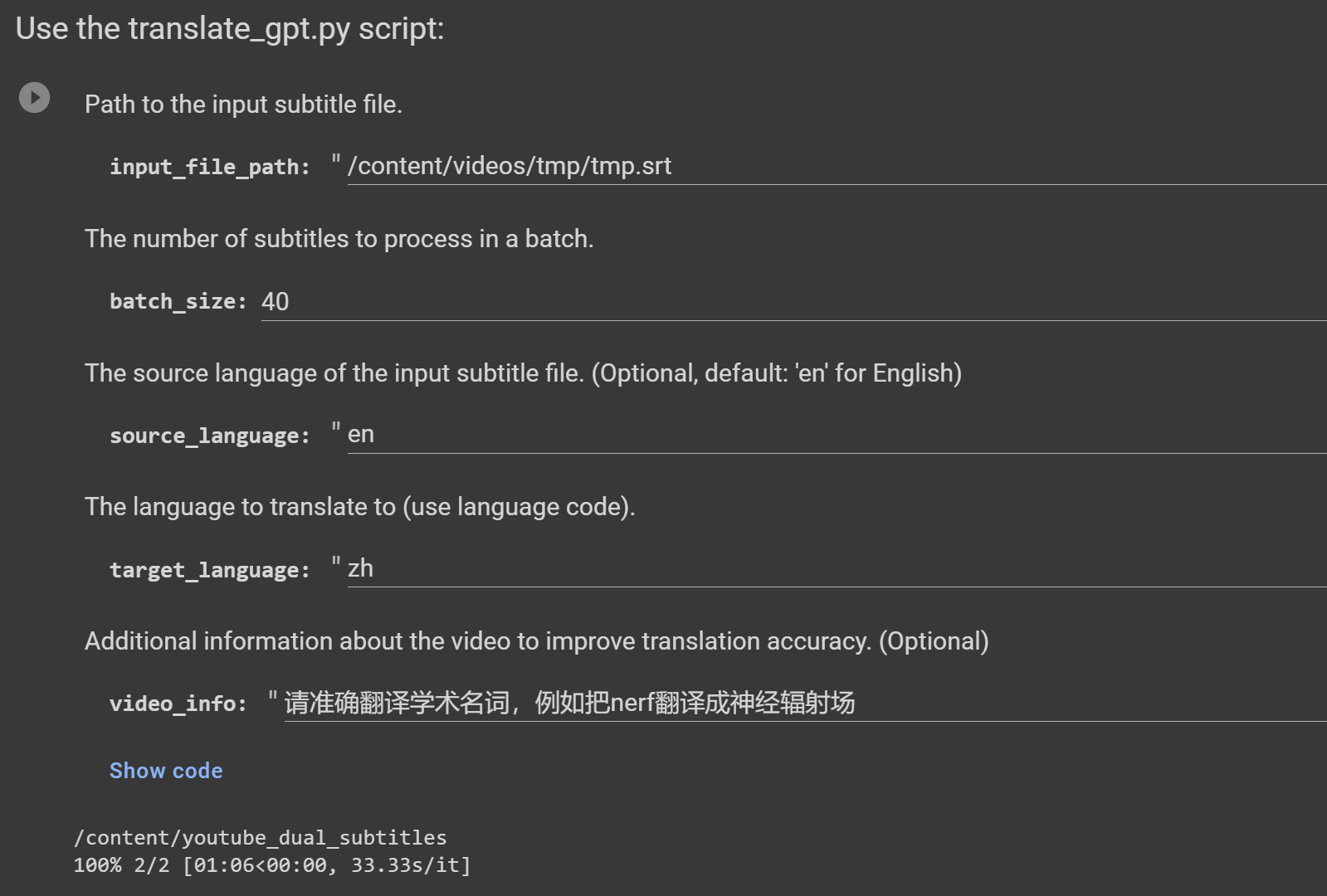下载 YouTube 视频(或提供您自己的视频)并使用 Whisper 和翻译API生成双语字幕,中文文档请见 中文
This project is a Python script that downloads a YouTube video (or uses a local video file), transcribes it, translates the transcript into a target language, and generates a video with dual subtitles (original and translated). The transcription and translation are powered by the Whisper model and the translation API (M2M100, google, GPT3.5), respectively.
GPT-3.5 translation compared to Google Translate

- Python 3.9 or later
- GPU (recommended for better performance)
Additionally, when running the script for first time, it will download the following pre-trained models:
- Whisper Model (small): ~461 MB
- Facebook M2M100 Model: ~2 GB (Optional, you can also use Google Translate API with googletrans, or Whisper's transcribe)
- OpenAI API key (Optional, if you want to use GPT-3.5 for subtitle translation)
- Clone this repository.
- Install the required dependencies using
pip install -r requirements.txt
You can provide either a YouTube URL or a local video file for processing. The script will transcribe the video, translate the transcript, and generate dual subtitles in the form of an SRT file.
python main.py --youtube_url [YOUTUBE_URL] --target_language [TARGET_LANGUAGE] --model [WHISPER_MODEL] --translation_method [TRANSLATION_METHOD]
-
--youtube_url: The URL of the YouTube video.
-
--local_video: The path to the local video file.
-
--target_language: The target language for translation (default: 'zh').
-
--model: Choose one of the Whisper models (default: 'small', choices: ['tiny', 'base', 'small', 'medium', 'large']).
-
--translation_method: The method to use for translation. (default: 'google', choices: ['m2m100', 'google', 'whisper', 'gpt', 'no_translate']).
-
--no_transcribe: Skip the transcription step. Assume there is a SRT file with the same name as the video file
Note: You must provide either --youtube_url or --local_video, but not both.
To download a YouTube video, transcribe it, and generate subtitles in target language using the google api to translate:
python main.py --youtube_url [YOUTUBE_URL] --target_language 'zh' --model 'small' --translation_method 'google'
To process a local video file, transcribe it, and generate subtitles in target language using gpt3.5-16k (you will need to provide an OpenAI API key)):
python main.py --local_video [VIDEO_FILE_PATH] --target_language 'zh' --model 'medium' --translation_method 'gpt'
The script will generate the following output files in the same directory as the input video:
- An SRT file containing the original transcribed subtitles.
- An SRT file containing subtitles that either merge two short lines together or split long lines into multiple lines.
- An SRT file containing the translated subtitles.
This script translates subtitles using OpenAI's GPT-3.5 language model. It requires an OpenAI API key to function. In most cases, GPT-based translation produce much better results compared to Google Translate, especially when dealing with context-specific translations or idiomatic expressions. This script aims to provide an alternative method for translating subtitles when traditional translation services like Google Translate do not produce satisfactory results.
- Sign up for an API key from OpenAI at https://platform.openai.com/account/api-keys
- Once you have the API key, create a file named .env in the same directory as the script.
- Add the following line to the .env file:
OPENAI_API_KEY=your_api_key_here
Replace your_api_key_here with the API key you obtained from OpenAI.
python translate_gpt.py --input_file INPUT_FILE_PATH [--batch_size BATCH_SIZE] [--target_language TARGET_LANGUAGE] [--source_language SOURCE_LANGUAGE] [--video_info VIDEO_INFO] [--model MODEL_NAME] [--no_mapping] [--load_tmp_file]
You can check the response.log file in the folder containing the input video file for live updates, similar to the experience with ChatGPT.
- --input_file: The path to the input subtitle file. (Required)
- --batch_size: The number of subtitles to process in a batch. (Optional, default: 40)
- --target_language: The target language for translation. (Optional, default: 'zh' for Simplified Chinese)
- --source_language: The source language of the input subtitle file. (Optional, default: 'en' for English)
- --video_info: Additional information about the video to improve translation accuracy. (Optional)
- --model: Model for OpenAI API, default to gpt-3.5-turbo-16k. (Optional)
- --no_mapping: Disables the use of translation mapping, a feature that ensures consistent translations for repeated terms. (Optional, flag)
- --load_tmp_file: Load the previous translated subtitles, assuming the previous tmp file was generated with the same settings as the current run. (Optional, flag)
Note:
-
Video Information: The
--video_infoargument accepts details in any language. It can be used to inform the GPT model about the video's content, improving the translation of context-specific terms, such as proper nouns within a game. For instance, if translating a video related to gaming, you might instruct GPT to use precise translations for in-game terminology. -
Translation Mapping: This functionality maintains consistency for frequently used terms by storing source-target translation pairs. When enabled, it prevents variations in translating terms like proper nouns and technical jargon across the video. Disable this with the
--no_mappingflag if preferred. -
Resuming Translations: Use the
--load_tmp_fileflag to continue a translation task from where it was previously interrupted. The script saves progress intmp_subtitles.json, allowing for a seamless resumption without redoing prior work. -
Language Support: While the script excels with English-to-Simplified Chinese translations, it can accommodate other language pairs. Enhance the accuracy for additional languages by adding tailored few-shot examples to
few_shot_examples.json. Note that the GPT models' performance may vary with multilingual inputs, and prompt adjustments intranslate_gpt.pymight be necessary.
Contributions are more than welcome!
- Fix the bug that prevents embedding dual subtitles into the video.
- Implement a GUI to make the tool more user-friendly.
- Let GPT summarize a list of word-to-word translation in its response and use it to improve translation consistency, and let human post-process the transcript by modify the dictionary.
- Use GPT4 to generate Few-shot examples for other language pairs, and make a JSON file for the examples.
- Explore the possibility of using offline small GPT models. (I tried some models on webGUI with the prompt, but they mostly output random text or translation that are worst than google translate)
- Fine-tune Whisper on (English audio, Chinese subtitle) dataset to improve x-to-Chinese translation accuracy
- use multi process to speed up the translation process
You can also try out this script using a Google Colab notebook. Click the link below to access the example:
Follow the instructions in the notebook to download the necessary packages and models, and to run the script on your desired YouTube video or local video file.
